2019 DODGE CHARGER SRT overheating
[x] Cancel search: overheatingPage 82 of 496
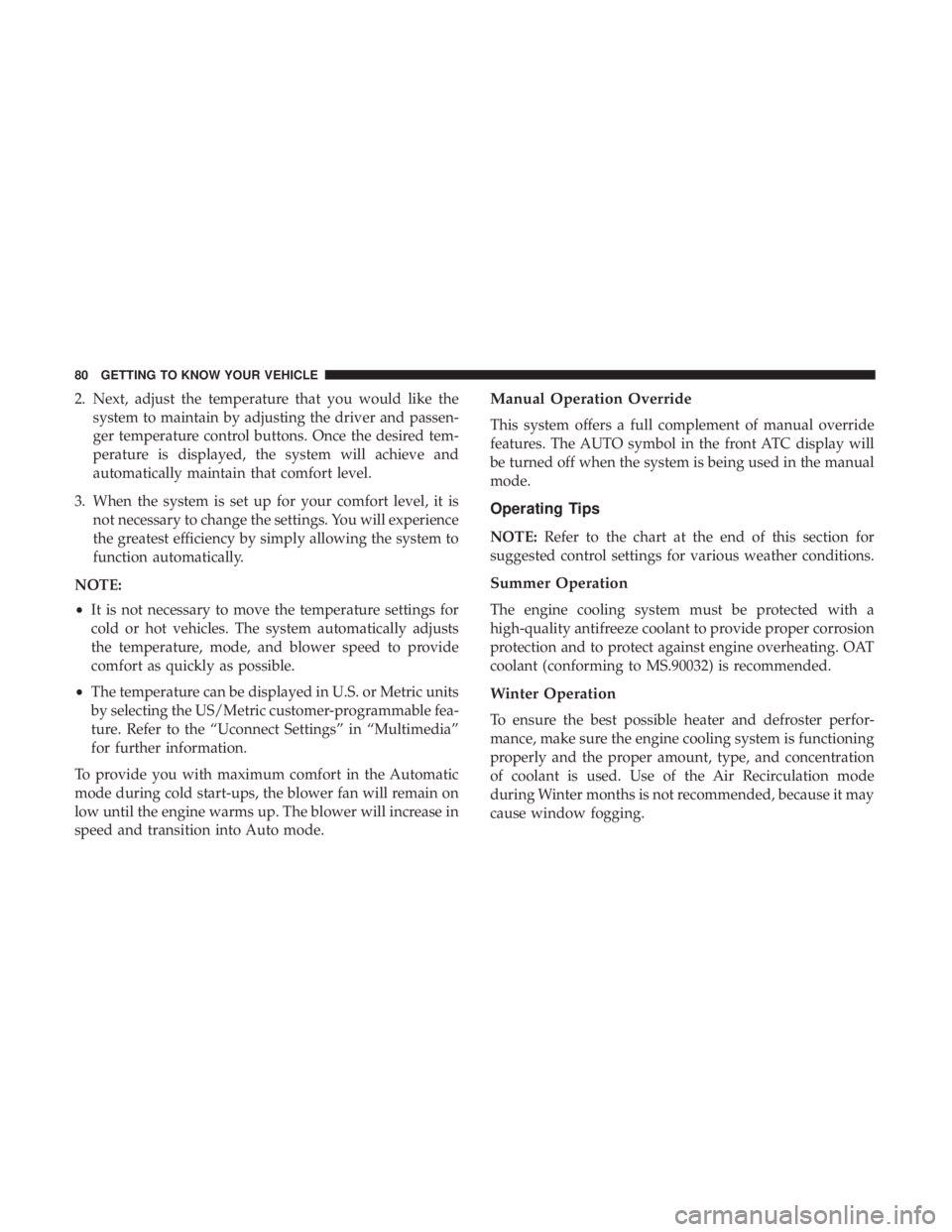
2. Next, adjust the temperature that you would like thesystem to maintain by adjusting the driver and passen-
ger temperature control buttons. Once the desired tem-
perature is displayed, the system will achieve and
automatically maintain that comfort level.
3. When the system is set up for your comfort level, it is not necessary to change the settings. You will experience
the greatest efficiency by simply allowing the system to
function automatically.
NOTE:
• It is not necessary to move the temperature settings for
cold or hot vehicles. The system automatically adjusts
the temperature, mode, and blower speed to provide
comfort as quickly as possible.
• The temperature can be displayed in U.S. or Metric units
by selecting the US/Metric customer-programmable fea-
ture. Refer to the “Uconnect Settings” in “Multimedia”
for further information.
To provide you with maximum comfort in the Automatic
mode during cold start-ups, the blower fan will remain on
low until the engine warms up. The blower will increase in
speed and transition into Auto mode.Manual Operation Override
This system offers a full complement of manual override
features. The AUTO symbol in the front ATC display will
be turned off when the system is being used in the manual
mode.
Operating Tips
NOTE: Refer to the chart at the end of this section for
suggested control settings for various weather conditions.
Summer Operation
The engine cooling system must be protected with a
high-quality antifreeze coolant to provide proper corrosion
protection and to protect against engine overheating. OAT
coolant (conforming to MS.90032) is recommended.
Winter Operation
To ensure the best possible heater and defroster perfor-
mance, make sure the engine cooling system is functioning
properly and the proper amount, type, and concentration
of coolant is used. Use of the Air Recirculation mode
during Winter months is not recommended, because it may
cause window fogging.
80 GETTING TO KNOW YOUR VEHICLE
Page 98 of 496
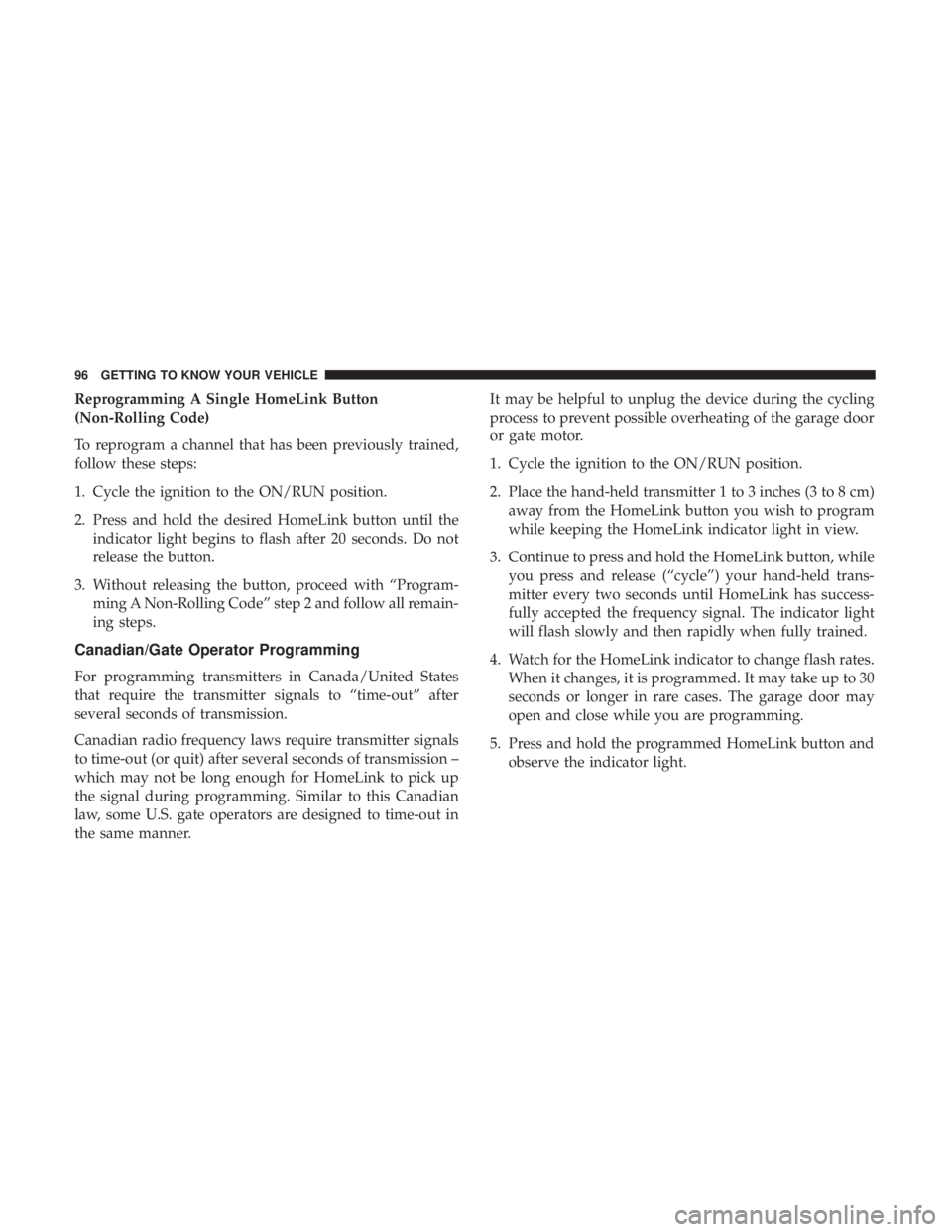
Reprogramming A Single HomeLink Button
(Non-Rolling Code)
To reprogram a channel that has been previously trained,
follow these steps:
1. Cycle the ignition to the ON/RUN position.
2. Press and hold the desired HomeLink button until theindicator light begins to flash after 20 seconds. Do not
release the button.
3. Without releasing the button, proceed with “Program- ming A Non-Rolling Code” step 2 and follow all remain-
ing steps.
Canadian/Gate Operator Programming
For programming transmitters in Canada/United States
that require the transmitter signals to “time-out” after
several seconds of transmission.
Canadian radio frequency laws require transmitter signals
to time-out (or quit) after several seconds of transmission –
which may not be long enough for HomeLink to pick up
the signal during programming. Similar to this Canadian
law, some U.S. gate operators are designed to time-out in
the same manner. It may be helpful to unplug the device during the cycling
process to prevent possible overheating of the garage door
or gate motor.
1. Cycle the ignition to the ON/RUN position.
2. Place the hand-held transmitter 1 to 3 inches (3 to 8 cm)
away from the HomeLink button you wish to program
while keeping the HomeLink indicator light in view.
3. Continue to press and hold the HomeLink button, while you press and release (“cycle”) your hand-held trans-
mitter every two seconds until HomeLink has success-
fully accepted the frequency signal. The indicator light
will flash slowly and then rapidly when fully trained.
4. Watch for the HomeLink indicator to change flash rates. When it changes, it is programmed. It may take up to 30
seconds or longer in rare cases. The garage door may
open and close while you are programming.
5. Press and hold the programmed HomeLink button and observe the indicator light.
96 GETTING TO KNOW YOUR VEHICLE
Page 322 of 496
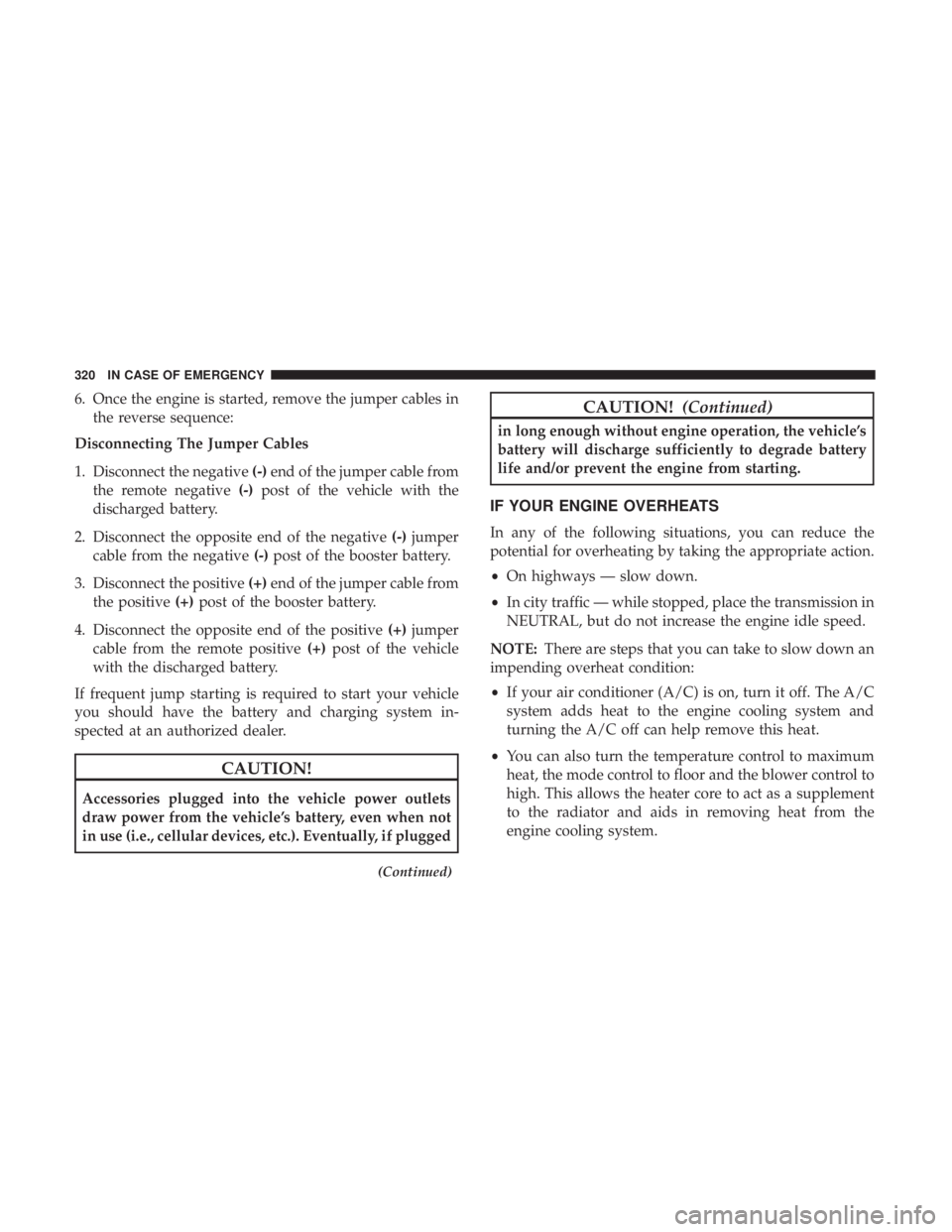
6. Once the engine is started, remove the jumper cables inthe reverse sequence:
Disconnecting The Jumper Cables
1. Disconnect the negative (-)end of the jumper cable from
the remote negative (-)post of the vehicle with the
discharged battery.
2. Disconnect the opposite end of the negative (-)jumper
cable from the negative (-)post of the booster battery.
3. Disconnect the positive (+)end of the jumper cable from
the positive (+)post of the booster battery.
4. Disconnect the opposite end of the positive (+)jumper
cable from the remote positive (+)post of the vehicle
with the discharged battery.
If frequent jump starting is required to start your vehicle
you should have the battery and charging system in-
spected at an authorized dealer.
CAUTION!
Accessories plugged into the vehicle power outlets
draw power from the vehicle’s battery, even when not
in use (i.e., cellular devices, etc.). Eventually, if plugged
(Continued)
CAUTION! (Continued)
in long enough without engine operation, the vehicle’s
battery will discharge sufficiently to degrade battery
life and/or prevent the engine from starting.
IF YOUR ENGINE OVERHEATS
In any of the following situations, you can reduce the
potential for overheating by taking the appropriate action.
•On highways — slow down.
• In city traffic — while stopped, place the transmission in
NEUTRAL, but do not increase the engine idle speed.
NOTE: There are steps that you can take to slow down an
impending overheat condition:
• If your air conditioner (A/C) is on, turn it off. The A/C
system adds heat to the engine cooling system and
turning the A/C off can help remove this heat.
• You can also turn the temperature control to maximum
heat, the mode control to floor and the blower control to
high. This allows the heater core to act as a supplement
to the radiator and aids in removing heat from the
engine cooling system.
320 IN CASE OF EMERGENCY
Page 326 of 496
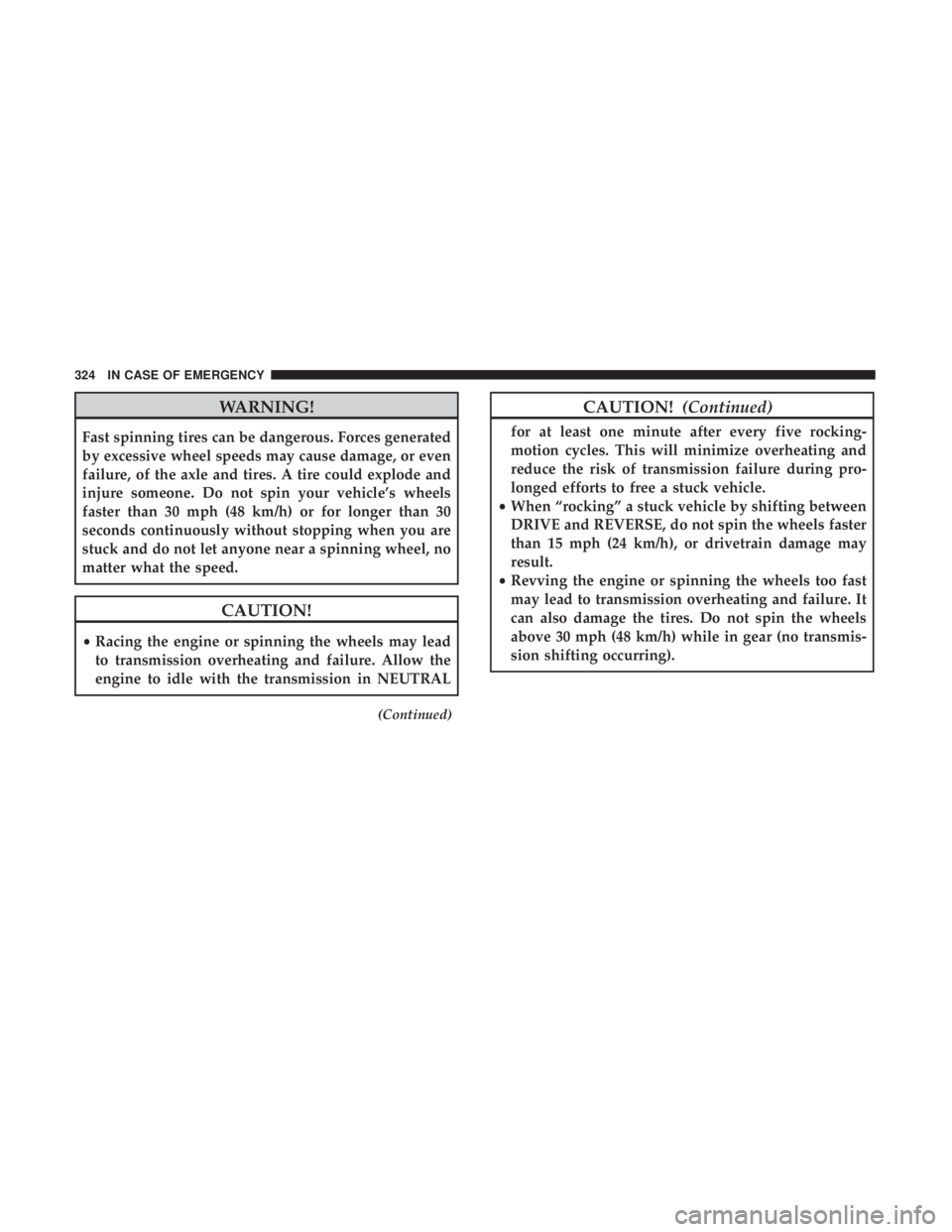
WARNING!
Fast spinning tires can be dangerous. Forces generated
by excessive wheel speeds may cause damage, or even
failure, of the axle and tires. A tire could explode and
injure someone. Do not spin your vehicle’s wheels
faster than 30 mph (48 km/h) or for longer than 30
seconds continuously without stopping when you are
stuck and do not let anyone near a spinning wheel, no
matter what the speed.
CAUTION!
•Racing the engine or spinning the wheels may lead
to transmission overheating and failure. Allow the
engine to idle with the transmission in NEUTRAL
(Continued)
CAUTION! (Continued)
for at least one minute after every five rocking-
motion cycles. This will minimize overheating and
reduce the risk of transmission failure during pro-
longed efforts to free a stuck vehicle.
• When “rocking” a stuck vehicle by shifting between
DRIVE and REVERSE, do not spin the wheels faster
than 15 mph (24 km/h), or drivetrain damage may
result.
• Revving the engine or spinning the wheels too fast
may lead to transmission overheating and failure. It
can also damage the tires. Do not spin the wheels
above 30 mph (48 km/h) while in gear (no transmis-
sion shifting occurring).
324 IN CASE OF EMERGENCY
Page 349 of 496
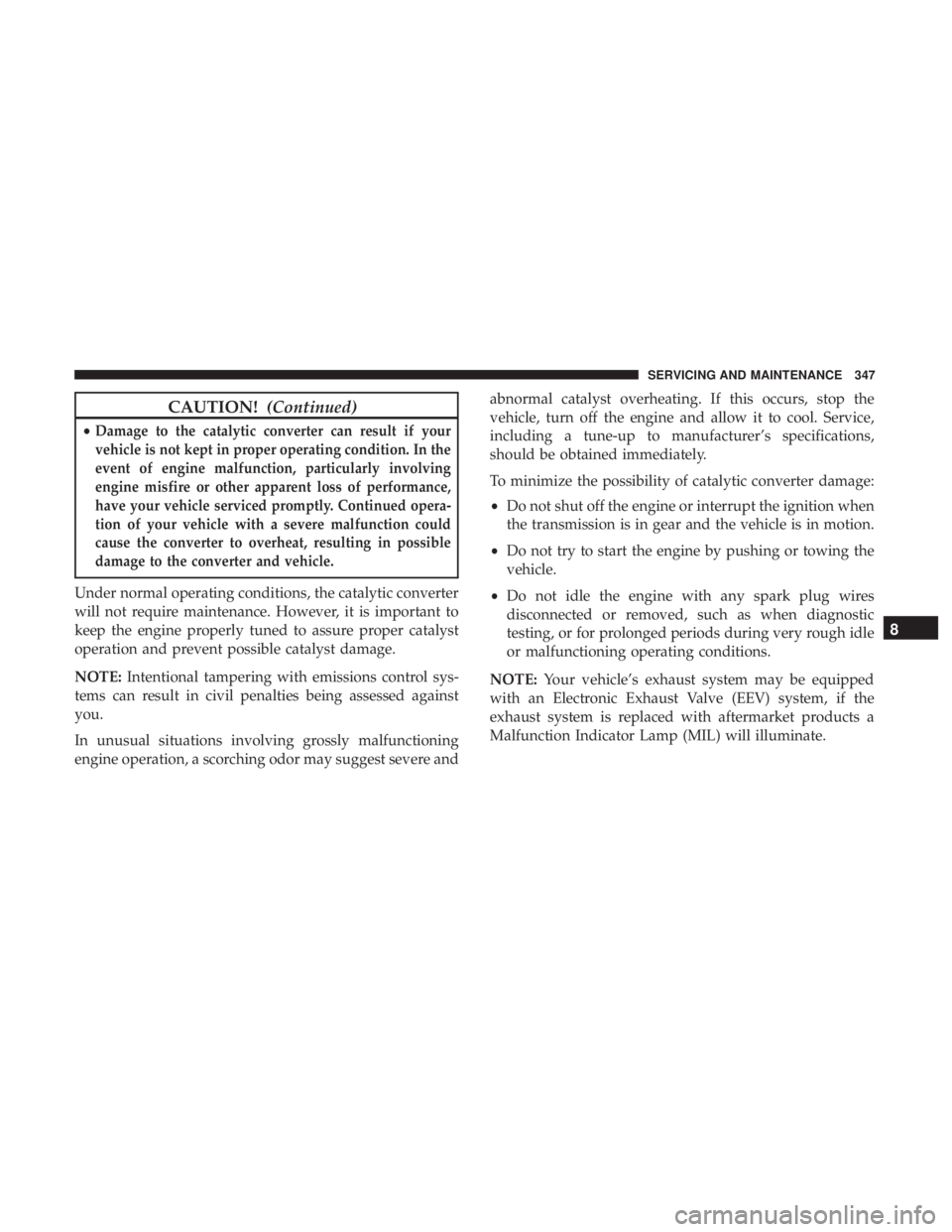
CAUTION!(Continued)
•Damage to the catalytic converter can result if your
vehicle is not kept in proper operating condition. In the
event of engine malfunction, particularly involving
engine misfire or other apparent loss of performance,
have your vehicle serviced promptly. Continued opera-
tion of your vehicle with a severe malfunction could
cause the converter to overheat, resulting in possible
damage to the converter and vehicle.
Under normal operating conditions, the catalytic converter
will not require maintenance. However, it is important to
keep the engine properly tuned to assure proper catalyst
operation and prevent possible catalyst damage.
NOTE: Intentional tampering with emissions control sys-
tems can result in civil penalties being assessed against
you.
In unusual situations involving grossly malfunctioning
engine operation, a scorching odor may suggest severe and abnormal catalyst overheating. If this occurs, stop the
vehicle, turn off the engine and allow it to cool. Service,
including a tune-up to manufacturer’s specifications,
should be obtained immediately.
To minimize the possibility of catalytic converter damage:
•
Do not shut off the engine or interrupt the ignition when
the transmission is in gear and the vehicle is in motion.
• Do not try to start the engine by pushing or towing the
vehicle.
• Do not idle the engine with any spark plug wires
disconnected or removed, such as when diagnostic
testing, or for prolonged periods during very rough idle
or malfunctioning operating conditions.
NOTE: Your vehicle’s exhaust system may be equipped
with an Electronic Exhaust Valve (EEV) system, if the
exhaust system is replaced with aftermarket products a
Malfunction Indicator Lamp (MIL) will illuminate.
8
SERVICING AND MAINTENANCE 347
Page 367 of 496
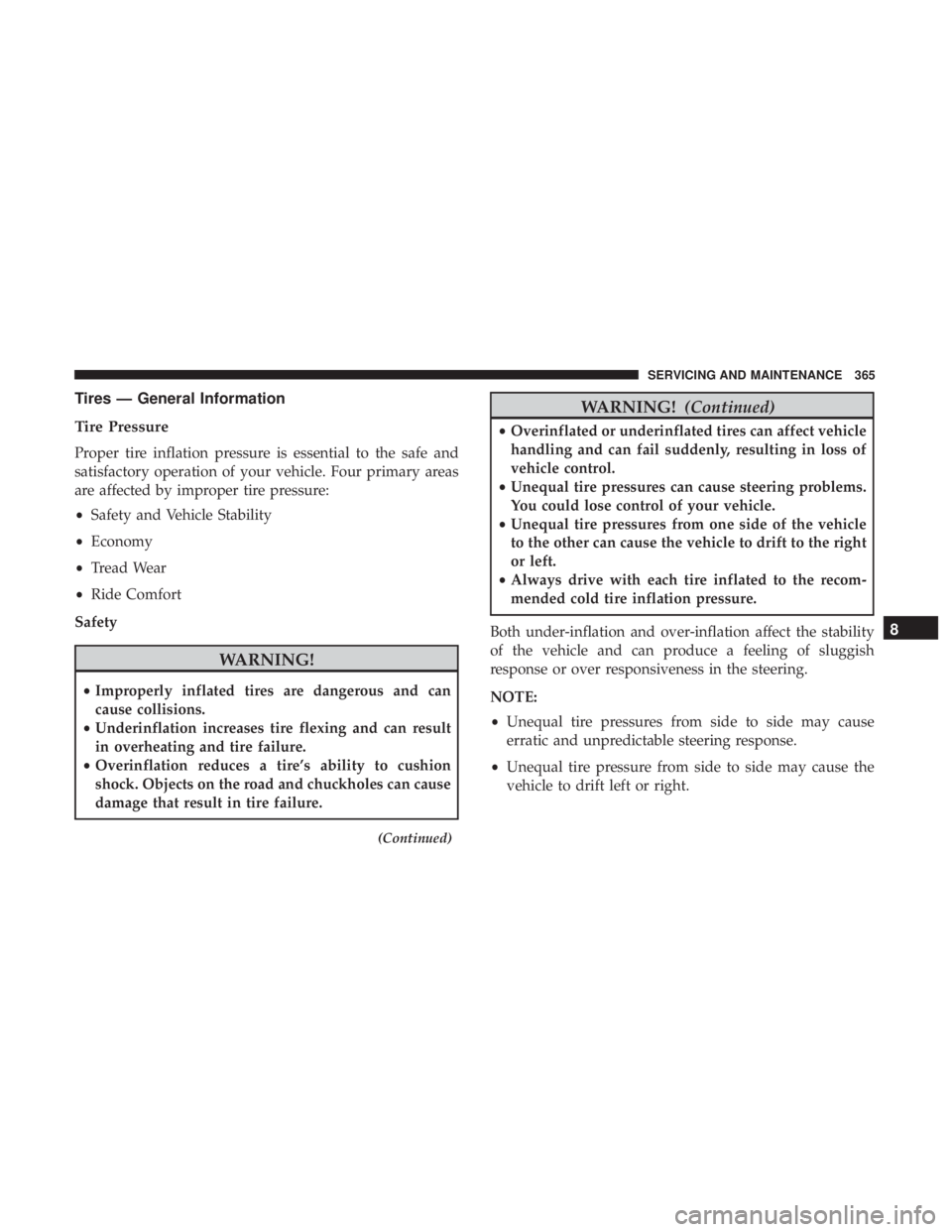
Tires — General Information
Tire Pressure
Proper tire inflation pressure is essential to the safe and
satisfactory operation of your vehicle. Four primary areas
are affected by improper tire pressure:
•Safety and Vehicle Stability
• Economy
• Tread Wear
• Ride Comfort
Safety
WARNING!
• Improperly inflated tires are dangerous and can
cause collisions.
• Underinflation increases tire flexing and can result
in overheating and tire failure.
• Overinflation reduces a tire’s ability to cushion
shock. Objects on the road and chuckholes can cause
damage that result in tire failure.
(Continued)
WARNING! (Continued)
•Overinflated or underinflated tires can affect vehicle
handling and can fail suddenly, resulting in loss of
vehicle control.
• Unequal tire pressures can cause steering problems.
You could lose control of your vehicle.
• Unequal tire pressures from one side of the vehicle
to the other can cause the vehicle to drift to the right
or left.
• Always drive with each tire inflated to the recom-
mended cold tire inflation pressure.
Both under-inflation and over-inflation affect the stability
of the vehicle and can produce a feeling of sluggish
response or over responsiveness in the steering.
NOTE:
• Unequal tire pressures from side to side may cause
erratic and unpredictable steering response.
• Unequal tire pressure from side to side may cause the
vehicle to drift left or right.
8
SERVICING AND MAINTENANCE 365
Page 484 of 496
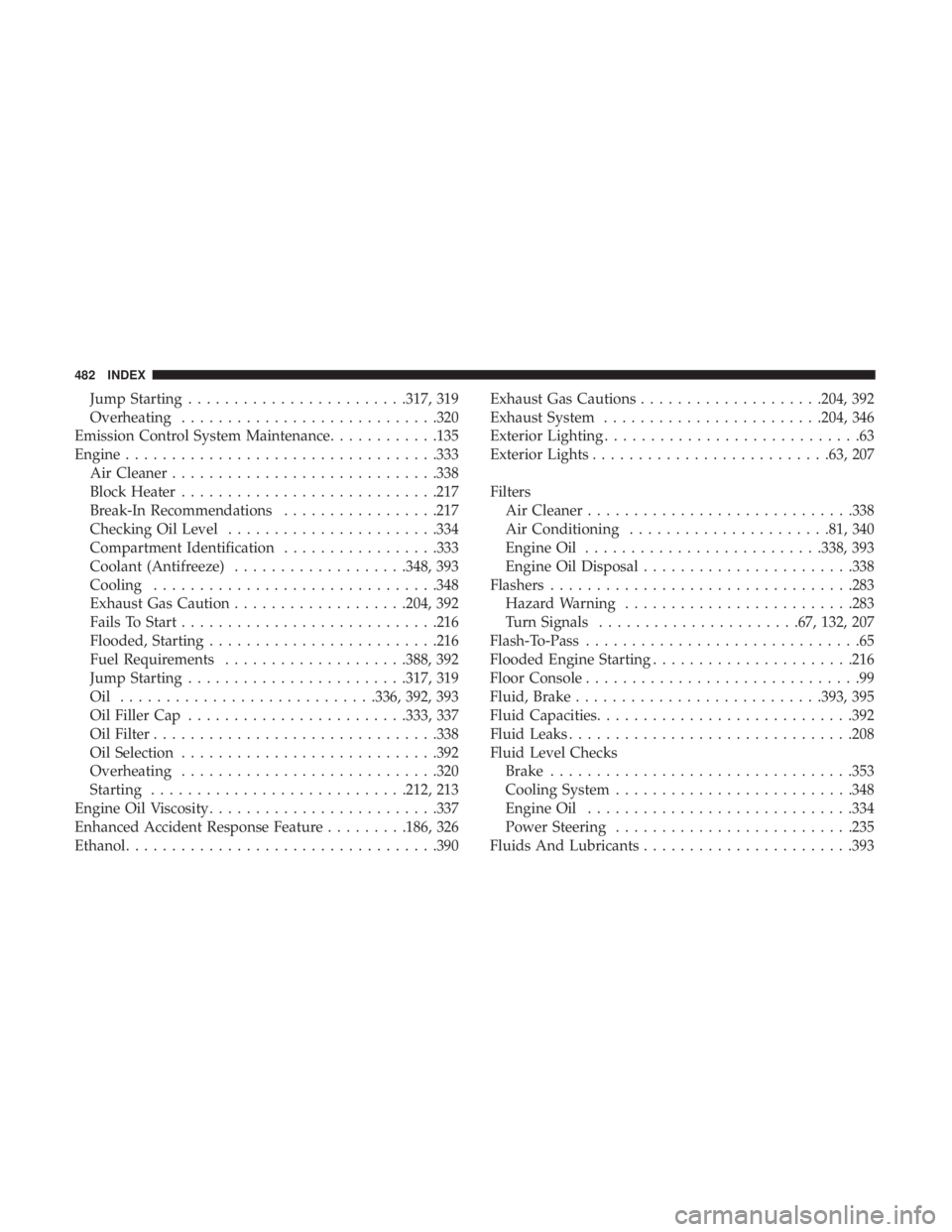
Jump Starting....................... .317, 319
Overheating ........................... .320
Emission Control System Maintenance ............135
Engine ................................. .333
Air Cleaner ............................ .338
Block Heater ........................... .217
Break-In Recommendations .................217
Checking Oil Level ...................... .334
Compartment Identification .................333
Coolant (Antifreeze) ...................348, 393
Cooling .............................. .348
Exhaust Gas Caution ...................204, 392
Fails To Start ........................... .216
Flooded, Starting ........................ .216
Fuel Requirements ....................388, 392
Jump Starting ....................... .317, 319
Oil ........................... .336, 392, 393
Oil Filler Cap ....................... .333, 337
Oil Filter .............................. .338
Oil Selection ........................... .392
Overheating ........................... .320
Starting ........................... .212, 213
Engine Oil Viscosity ........................ .337
Enhanced Accident Response Feature .........186, 326
Ethanol ................................. .390Exhaust Gas Cautions
....................204, 392
Exhaust System ....................... .204, 346
Exterior Lighting ............................63
Exterior Lights ......................... .63, 207
Filters Air Cleaner ............................ .338
Air Conditioning ..................... .81, 340
Engine Oil ......................... .338, 393
Engine Oil Disposal ...................... .338
Flashers ................................ .283
Hazard Warning ........................ .283
T
urn Signals ..................... .67, 132, 207
Flash-To-Pass ..............................65
Flooded Engine Starting ..................... .216
Floor Console ..............................99
Fluid, Brake .......................... .393, 395
Fluid Capacities ........................... .392
Fluid Leaks .............................. .208
Fluid Level Checks Brake ................................ .353
Cooling System ......................... .348
Engine Oil ............................ .334
Power Steering ......................... .235
Fluids And Lubricants ...................... .393
482 INDEX
Page 488 of 496
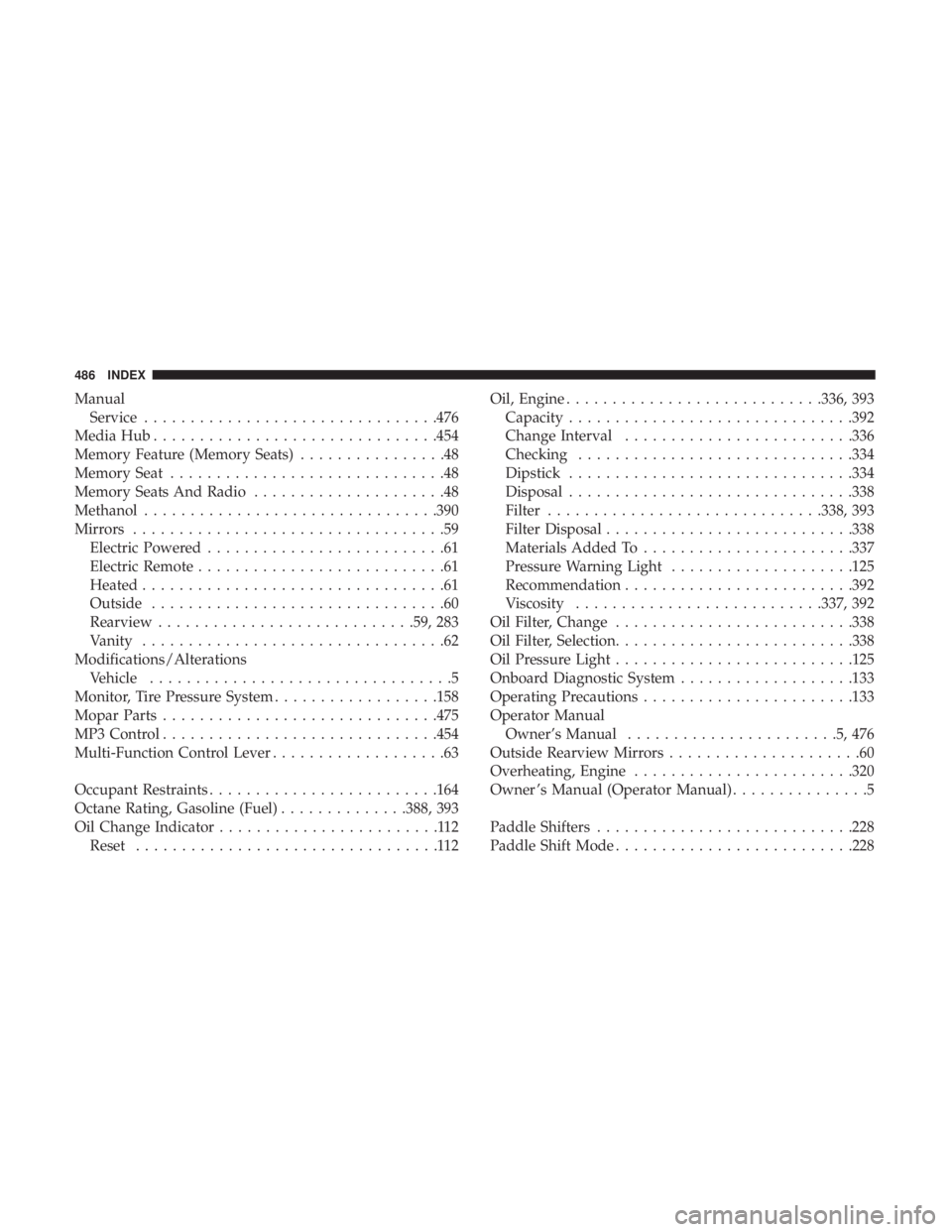
ManualService ............................... .476
Media Hub .............................. .454
Memory Feature (Memory Seats) ................48
Memory Seat ..............................48
Memory Seats And Radio .....................48
Methanol ............................... .390
Mirrors ..................................59
Electric Powered ..........................61
Electric Remote ...........................61
Heated .................................61
Outside ................................60
Rearview ........................... .59, 283
Vanity .................................62
Modifications/Alterations Vehicle .................................5
Monitor, Tire Pressure System ..................158
Mopar Parts ............................. .475
MP3 Control ............................. .454
Multi-Function Control Lever ...................63
Occupant Restraints ........................ .164
Octane Rating, Gasoline (Fuel) ..............388, 393
Oil Change Indicator ........................112
Reset .................................112 Oil, Engine
........................... .336, 393
Capacity .............................. .392
Change Interval ........................ .336
Checking ............................. .334
Dipstick .............................. .334
Disposal .............................. .338
Filter ............................. .338, 393
Filter Disposal .......................... .338
Materials Added To ...................... .337
Pressure Warning Light ....................125
Recommendation ........................ .392
Viscosity .......................... .337, 392
Oil Filter, Change ......................... .338
Oil Filter, Selection ......................... .338
Oil Pressure Light ......................... .125
Onboard Diagnostic System ...................133
Operating
Precautions ...................... .133
Operator Manual Owner’s Manual .......................5,476
Outside Rearview Mirrors .....................60
Overheating, Engine ....................... .320
Owner ’s Manual (Operator Manual) ...............5
Paddle Shifters ........................... .228
Paddle Shift Mode ......................... .228
486 INDEX